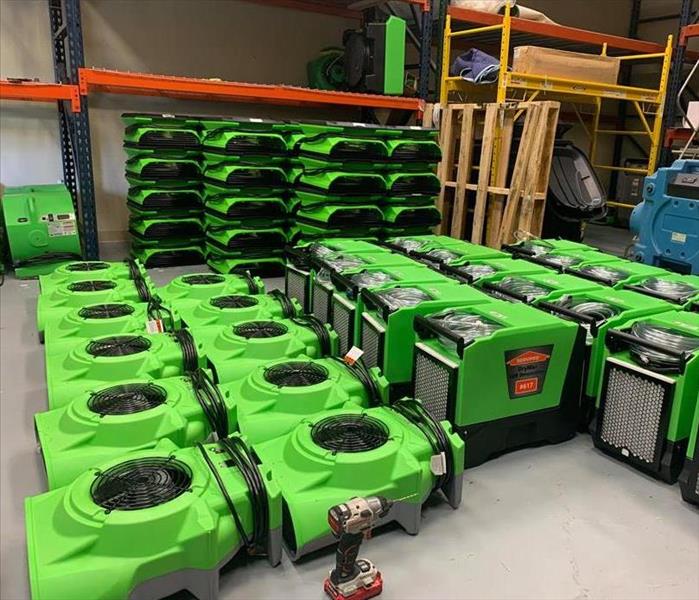Water Damage Restoration: Moisture Detection and Drying Equipment
8/31/2020 (Permalink)
 SERVPRO of Greater Covington and Mandeville has a wide variety of moisture measuring tools, air movers, and dehumidification equipment.
SERVPRO of Greater Covington and Mandeville has a wide variety of moisture measuring tools, air movers, and dehumidification equipment.
Professional water damage restoration includes proper damage assessment, water extraction, and drying techniques. Our water damage restoration technicians receive certifications from the Institute of Inspection Cleaning and Restoration Certification, a non-profit organization focused on setting standards for the inspection, cleaning, and restoration industries. Certified, trained, and equipped with the following state-of-the-art restoration tools, our water damage restoration team makes any size disaster seem “Like it never even happened.”
Step 1: Damage Assessment- Utilize Moisture Detection Equipment
The initial steps in the water damage restoration process are to assess the damages and locate where water has traveled. Our water damage restoration technicians seek to understand which materials were affected and how saturated they are. During the investigation, the restoration professional notes all materials, building components, and contents affected by the water as well as saturation levels.
- Moisture meters- Used to measure the amount of water content in materials such as drywall, flooring, or baseboards. Moisture meters come in two main types: penetrating and non –penetrating.
- Penetrating meters have surface-piercing prongs that work on the principle of electrical conductivity, which identifies trapped moisture on various surfaces. Penetrating meters like moisture probes determine the saturation on a percentage scale. By comparing non-affected materials to affected materials, our team determines the drying standards for specific materials.
- Non-Penetrating meters are equipped with two sensors and use conductivity or radio frequencies to detect moisture. Thermal infrared cameras are non-penetrating tools our team uses to determine which materials are saturated. These cameras capture images in hard to reach locations and save images in a microSD card. Thermal imaging cameras are perfect for detecting water inside wall cavities and under cabinets.
- Hygrometers- Used to measure both temperature and humidity concentration within the water-loss areas. Hygrometers help determine humidity levels which allow restoration professionals to determine how to stabilize the environment for adequate drying.
Once the extent of damages is determined and water class and category have been identified, our water damage restoration professionals will construct the water extraction plan.
Step 2: Water Extraction- Utilize Professional Extraction Equipment
SERVPRO of Greater Covington and Mandeville has a variety of water extraction equipment. Variables such as type of flooring, water depth, and power availability will determine which pumps and extraction tools should be used. Our goal is to extract as much water as possible as quickly as possible to prevent secondary damages.
- Extraction units- Are portable or truck mounted. Portable units can be taken almost anywhere but require an electric power supply. Portable units can hold about a dozen gallons of water before needing to be dumped. For larger jobs or those without a power source, our restoration professionals will opt to use our truck-mounted extraction equipment. The truck’s tank can hold seventy-five gallons of water.
- Carpet wands- Carpet wands attach to all extraction units.
- Pumps- Remove standing water that is more than 2 inches deep. Submersible pumps can be used to quickly remove standing water in hard to access areas like basements, crawl spaces, and construction sites.
After all loose water has been extracted, the drying process will commence.
Step 3: The Drying Process- Utilize Drying and Dehumidification Equipment
Water restoration professionals strategically place drying equipment throughout affected rooms. We adhere to IICRC drying standards and Xactimate, a restoration software used by all insurance industry professionals, to determine how many pieces of each equipment are necessary and how best to arrange them.
- Air movers- Air movers are positioned to create a vortex of airflow to promote faster drying. Increasing the rate of evaporation, rapid air movement reduces the chances of secondary damages like mold growth. The two main types of air movers are centrifugal air movers and axial air movers.
- Dehumidifiers- Used to remove water vapor from the air. Dehumidifiers intake moist air, remove water, and exhausts warm, dry air. Two types of dehumidifiers are low grain refrigerants (LGRs) and desiccants.
- LGRs work on the premise of condensation and work best in temperatures between 70 degrees and 90 degrees Fahrenheit. Moist air moves across cold evaporator coils and is cooled below its dew point, condensing water on the cold coils and fins. Water is drained off the fins into a collection tank and pumped out into a sink or water barrel.
- Desiccant dehumidifiers work on the premise of condensation and are most efficiently remove moisture in temperatures below 70 degrees. Desiccants use a silica gel to absorb moisture.
Each day during the drying process, our restoration technicians will return to monitor material moisture content, check the temperature, and calculate the humidity ratio. All equipment will be inspected and rearranged if necessary. Equipment will be removed as specific materials and areas are deemed dry. The drying process is typically complete within three days.
If your home or business has been affected by a water damage event, then please contact our office by dialing 985-871-5375. Our emergency water restoration team is available 24/7/365 to serve our friends and neighbors in Covington, Mandeville, Abita Springs, Madisonville, and Folsom.






 24/7 Emergency Service
24/7 Emergency Service